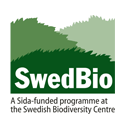Under the UVIMA Project regional thematic teams have produced keys and fact sheets to help consolidate and mobilise crucial taxonomic information that is fundamental to support decision making, policy development and action as well back-stop research, agricultural extension work and biodiversity conservation in three countries in Eastern Africa: Kenya, Tanzania and Uganda.
Invasive Plants of East Africa (Kenya, Tanzania and Uganda)
Under the UVIMA Project a list of over 100 of the most serious invasive plant species in the region was produced. This list was used as a basis for the production of a key to 119 species of invasive plants. There are also fact sheets to each of these species. The key is designed to be used as a simple identification tool for conservationists, extensionists and some farmers, to provide an overview of the invasive plant species and possible management measures and to provide first port of call for somebody interested in invasive plant species in the region (links to more detailed sources of information are provided).
Invertebrate pests of maize in East Africa (Kenya, Tanzania and Uganda)
Maize is the principal staple crop of the region and farmers experience enormous losses of yield to invertebrate pests both in the field and in storage. The key to 26 invertebrate pest groups that cause serious damage to maize together with accompanying fact sheets (to all the insect groups represented in the key) is to be used as a simple identification tool for extensionists & some farmers, to provide an overview of the pest and possible management measures and as a first port of call for somebody interested in pests of maize (links to more detailed sources of information are provided).
The Bee genera of East Africa (Kenya, Uganda and Tanzania)
The key and accompanying fact sheets provide a means of identifying the 20 bee genera of the region - the most important group pollinator group for wild and cultivated plants in the region. The key is designed to be used as a simple identification tool for conservationists, extensionists and some farmers, to provide an overview of role of bees in the conservation of ecosystem services, the possible management measures that can be used to conserve pollinators and to provide first port of call for somebody interested in pollinators and pollination in the region (links to more detailed sources of information are provided).
Best practice guidelines for making an identification using Lucid Player
To begin an identification, first make sure your computer meets the Lucid3 "System Requirements." It is strongly recommended that you then read the "Best Practice Guidelines" for making an identification before actually using the key the first time.
To start the key, click either of the "START KEY" links. Note that the interactive key may be very slow (taking often up to several minutes) to open.
During an identification session with an interactive key, Lucid allows you to choose any character (i.e., a feature and its associated states) from the Features Available list at any time. However, “stepping�? through the key in a structured and sensible way will make your task of identification more efficient. Below are recommendations for increasing your efficiency and decreasing the amount of time required for identifying an unknown specimen using Lucid Player.
Preliminary Notice regarding ordering of taxa in Entities Remaining
The Lucid Player is designed so that, as you choose states, the taxa left in Entities Remaining are ordered so that the taxa that best match the chosen states are at the top. Note that this ordering will ONLY HAPPEN if you choose Lists at the bottom of the Entities Discarded panel. This ordering WILL NOT HAPPEN if you are viewing the default of Trees.
Familiarity with the specimen
First, become familiar with the characteristics of the specimen you wish to identify. If you are also familiar with the Lucid key that you will use, then you may already know many of the specimen's characteristics. Briefly reviewing these characteristics before you start will make it easier for you to proceed through the identification.
Note and use distinctive features
In any key, some taxa may possess particularly distinctive features and/or states. Use of these may allow the taxon to be keyed out in a very few steps. At the very least, starting with any particularly distinctive or striking features your specimen may possess for the first features you select may quickly reduce the list of Entities Remaining.
Answer easy features first
Browse the list of Features Available and address easy features first. The principles of dichotomous keys, in which the couplets must be answered in a preset order, are very familiar to most key users who often automatically apply these principles to a matrix key. Although Lucid3 lists the features of a key in an initial sequence in the opening window, this does not mean that the features must be selected in that order. You can select any feature from any position in the list. (Note that in some keys, where positive dependencies are used, you may be forced to answer specific questions (features) before others become available.).
Most Lucid3 keys will have a wide variety of features, ranging from those dealing with obvious and simple features to those dealing with features that are minute, obscure, or difficult to interpret. Always start by browsing the list of Features Available for obvious features that you can quite quickly answer, as opposed to getting stuck on the first one. Lucid software is designed to overcome problems associated with difficult and obscure features.
It's okay to skip features
In looking through the features, you may not be sure which state of a feature to choose, or a feature or state may not be clear on your specimen. Skipping the feature entirely in such cases is always an option.
Use illustrated feature notes
As you work through the list of Features Available, you may find some features or feature states that you do not understand. If so, review any explanatory notes and illustrations that may be associated with the features and states. Each taxon featured comes with an attached fact sheet which may help you to familiarise yourself with the species.
Choosing multiple states
You can always choose multiple states (more than one state of a feature) if you are uncertain which state is the correct one to choose for a particular specimen. Lucid software is designed to allow you to choose as many states as you require from any one feature (if, e.g., your specimen is in between two states, or exhibits two or more states). Within the program's logic, these states will be connected by an “or�? link. This will cause Lucid to search for all taxa with any of the states you select. As a general rule, if you are unsure which of two or more states your specimen has, then choose them all. That way, you can be sure that your target taxon will remain in Entities Remaining. (Note that in the Lucid3 Player users can choose the matching method option of “all states�? rather than the usual default of “any states�?. See Help for more information.).
Finding the best feature to address next
When you have dealt with all the obvious features, use Lucid's "Best" function to suggest the best remaining feature that will give you the most efficient next step. The Best algorithm will assess which of the remaining features and states available will best reduce the list of Entities Remaining. The Lucid Player has two “Best�? modes: "Find Best" and "Sort Best".
- Find Best – In the Lucid3 Player, clicking the Find Best Feature button will cause the Player to move to and open the best available feature. Find Next Best Feature and Find Previous Best Feature buttons on the toolbar allow navigation through the Features list, if you have difficulty addressing the first feature nominated. If the list of entities in Entities Remaining changes after choosing a feature as suggested by Best, you should click the Find Best Feature button again to recalculate the next best feature to address.
- Sort Best – Sort Best will reorder the Features Available list so that features are sorted from best to worst. After a Sort Best, scan the top of the list for features that you can answer most easily. (Note that Sort Best only works using List View, as a tree representation of features cannot be sorted.)
Other Lucid Player tools
You may find other Lucid3 tools helpful while navigating feature choices, such as "View Shortcut Features," "Prune Redundant Features," and "Calculate Differences." Explanations about how to use these functions are available through the Lucid Help menu.
What if no taxa remain?
This will happen sooner or later in one of your Lucid sessions. If no taxa are listed in the Entities Remaining window, then it simply means that no taxa in the database match the selection of states you have made. Several explanations are possible, but some of the most common are:
- You have made an error in one or more states that you have selected. This is the most likely error for any situation in which no taxa remain.
- The taxon may be undescribed or not one of those in the key. In this case Lucid cannot identify the specimen because its features are not represented in the key's data tables.
- The key author may have made an error when constructing the key. If, after carefully checking all the features and states and checking that the specimen you are attempting to identify would be expected to be included in the key, then a key construction error may be present.
Whichever of the above situations is suspected, you must very carefully review your chosen features and determine which ones you are uncertain about. Try unselecting uncertain states one by one to see what effect each has. One or more taxa may move back into the Entities Remaining window. In difficult cases, you may need to “play�? with the key, adding or deleting states progressively to try to find the best matching taxon.
What if several taxa remain?
Never assume that you will always end up with one taxon remaining. Some taxa in the key may be very hard to differentiate, except when using difficult or obscure features. Sometimes, after you have addressed all the features, you may have a short list of taxa remaining instead of just one taxon. You are still much closer to an identification than you otherwise would have been. You may then have to carefully check your specimen against associated information (descriptions, images, etc. for the remaining taxa) or refer to more advanced or specialist reference sources.
In some cases, if you have a short list of taxa remaining, but have not addressed all the features, it may be easier to check your specimen against information associated with these remaining taxa. This can sometimes be a faster way to make an identification, than trying to find a feature that will discriminate among the remaining taxa.
If your taxon does not look similar to any of the taxa remaining, you can use the same strategy described above, of unselecting states one by one, or “playing�? with the key, to find the best matching taxon.
Checking the result
Once you have made a preliminary identification, check the other information (such as notes, descriptions or images) provided for the taxon. Getting a possible name for a taxon from a key is not the end of an identification. You may have made errors, or your specimen may be a taxon that is not in the key. In these cases, the key may have provided you with the wrong name. The associated information will often give you a good indication as to whether the answer is correct.











